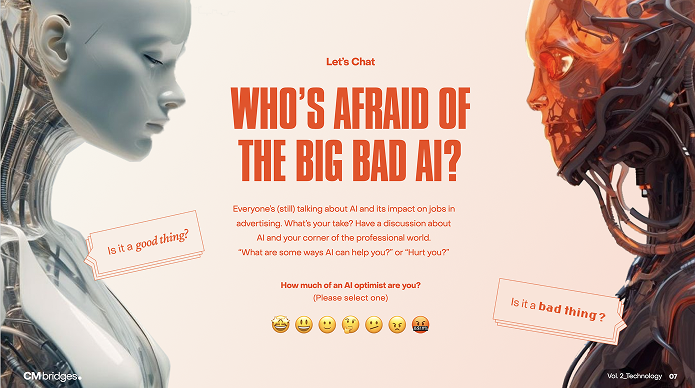
Spanning Generations, Building Inclusive Workplaces.
Spanning Generations,
Building Inclusive Workplaces.
THE CHALLENGE:
For the first time in history, five generations share the workplace. This brings energy, diversity, and a wealth of skills—but it can also magnify generational differences, with the potential to sometimes create friction and misalignment.
The challenge: design a program that not only acknowledges generational differences but celebrates them—building common ground, stronger relationships, and more productive workplaces.

THE CHALLENGE:
For the first time in history, five generations share the workplace. This brings energy, diversity, and a wealth of skills—but it can also magnify generational differences, with the potential to sometimes create friction and misalignment.

The challenge: design a program that not only acknowledges generational differences but celebrates them—building common ground, stronger relationships, and more productive workplaces.
THE SOLUTION:
In early 2023, we hosted a “Let’s Chat” with mentorship expert Lisa Fain on the topic of intergenerational mentorship. The session drew over 100 participants, and when asked if they would join such a program at Critical Mass, 95% said yes. That overwhelming response became the spark for Bridges.
Partnering with our Learning & Development team, I lead the design of a 9-month pilot program with an initial cohort of 34 participants. The program was built to foster connection, not hierarchy—each participant served as an “expert” on their own generation, sharing perspectives on equal footing.
THE SOLUTION:
In early 2023, we hosted a “Let’s Chat” with mentorship expert Lisa Fain on the topic of intergenerational mentorship. The session drew over 100 participants, and when asked if they would join such a program at Critical Mass, 95% said yes. That overwhelming response became the spark for Bridges.

Partnering with our Learning & Development team, I lead the design of a 9-month pilot program with an initial cohort of 34 participants. The program was built to foster connection, not hierarchy—each participant served as an “expert” on their own generation, sharing perspectives on equal footing.
To make the sessions meaningful, we created monthly guides covering topics like Technology, Communication, Collaboration, Work/Life Balance, and The Future. Each guide included three parts:
- Share: perspectives from each generation
- Activity: a practical exercise tied to the theme
- Discussion: a guided conversation to spark understanding and connection
To make the sessions meaningful, we created monthly guides covering topics like Technology, Communication, Collaboration, Work/Life Balance, and The Future. Each guide included three parts:
- Share: perspectives from each generation
- Activity: a practical exercise tied to the theme
- Discussion: a guided conversation to spark understanding and connection




We also took special care in matching pairs:
- One from the Rising Cohort (Gen Z, Millennials) paired with one from the Classic Cohort (Gen X, Baby Boomers)
- Different disciplines paired together (e.g., marketing with accounting) to avoid traditional mentorship dynamics
- Regional alignment where possible to encourage in-person interaction
The result: 17 intergenerational pairs committed two hours per month—one hour of guided exercises and one hour of partner conversation—to explore perspectives, bridge differences, and build stronger cross-generational collaboration.
WHAT WE LEARNED:
Pilots exist to surface insights—and Bridges did just that. Early enthusiasm was strong (95% interest), but sustained participation revealed some important realities:
- Time commitment: Two hours a month proved too heavy, especially for participants who didn’t see a direct career benefit.
- Soft skills vs. career drivers: Because the focus was on collaboration and understanding, rather than career advancement, engagement skewed lower over time.
- Common ground > differences: Perhaps the most valuable insight—participants gravitated toward shared values and experiences, not just generational contrasts.
WHAT WE LEARNED:
Pilots exist to surface insights—and Bridges did just that. Early enthusiasm was strong (95% interest), but sustained participation revealed some important realities:
- Time commitment: Two hours a month proved too heavy, especially for participants who didn’t see a direct career benefit.
- Soft skills vs. career drivers: Because the focus was on collaboration and understanding, rather than career advancement, engagement skewed lower over time.
- Common ground > differences: Perhaps the most valuable insight—participants gravitated toward shared values and experiences, not just generational contrasts.

LOOKING TOWARDS TO FUTURE:
These insights are already helping to shape manager training and culture at Critical Mass.
- Elements of Bridges are being integrated into manager training, equipping younger leaders with tools to manage older employees—and vice versa.
- We’re reimagining the format as community-building events, with shared meals, activities, and conversations designed to spark authentic, cross-generational connection in a lighter, more engaging way.
WHY IT MATTERS:
Workforce innovation isn’t about getting it perfect the first time—it’s about testing, learning, and evolving. Bridges demonstrated the demand for cross-generational connection and revealed how to make it sustainable.
By reframing mentorship as shared learning and common ground, we’re charting a path toward workplaces that are not just multigenerational, but truly inclusive.